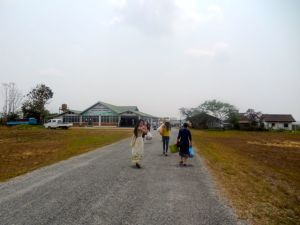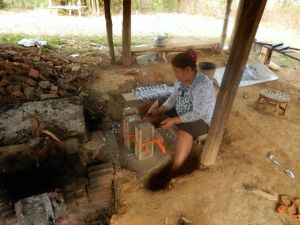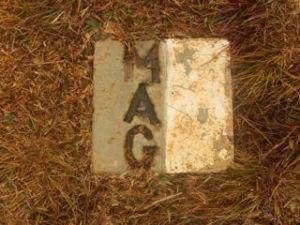 |
| Communist Flags at Hotel |
 |
| Airport at Phonsavan, Laos |
In one poverty-ridden country, a victim of bombing and brutality of that war, there is a sort of miracle. In the northern part of Laos, one arrives on a small crowded turbo-prop at an airport that reminded me of others in dusty, dry West Africa and remote spots in Nepal. But here there is an anticipated hope to learn something about making the best of the worst. And I have.
Not only are the Nmong people resilient from a wretched history (The USA did transport thousands of Nmong to settle in the states after their avid support of our troops in the Vietnam war and to protect them from Communist aftermath) but they are a simple, proud and hardworking patriarchal society and loyal Buddhists who hang on in their homeland. One doesn’t encounter temples on every corner (not many corners), but cemeteries on top of remote hills are circled in colorful temple-style spirit houses visible from long distances.
 |
| typical tribal home |
 |
| Looms and tractors at work |
In this cool and hazy part of Laos, Northern Laotians build houses on stilts out of wood, have no glass in the square cut out for window, but wooden shutters to close if needed. And usually next to the pickup truck, if one can afford one far out in the country, there will be one or two looms and a tractor and farm tools underneath. Barefoot women spend much of their day weaving the phaa sinh skirts of silk and cotton which almost all Lao women wear daily. They also clean and cook rice for every meal.
 |
| Spoons from Bombs |
 |
| Bombs for Work |
After a dusty rough hour drive (few paved roads) we came to a niche in the landscape called Spoon Village. To prove the initiative of the Nmong tribes, one family buys detonated bombs (including the strange ball-shaped cluster bombs) and other parts to make aluminum spoons, bottle openers and arm bangles. They use a primitive way of heating the aluminum and pouring it into a soup spoon mold where it dries. Once they received an order for 8000 spoons to be completed in a day. They got it doe.
The miracle is that the hill tribes not only survived the continual deadly bombing of both sides of the war, but they live in an archaeological paradise suggesting there was a rich culture here 2500 years ago. Strewn over hill, dale and dry rice paddies are over 2000 stone jars, some taller than I am, cut from a single nearby mountain, and which were placed at, rolled to or mysteriously arrived at 58 sites called Plain of Jars. Whatever the experts surmise – were they funerary urns (ashes and a bone in a clay pot have been found here by the first archaeologist), grain containers or wine vats for a king who partied – these places speak to the spirit.
 |
| Plain of Jars Site 1 |
 |
| Plain of Jars Site 3 |
We visited two of the sites: Site 1, Thong Hai Hin,with 331 jars strewn haphazardly across the fields and on one jar there is a carved image of a man with his arms up crucifix style, and Site 3 (Hai Hin Lat Khai. One has to balance along hard paths, dubious fences to be hurdled, rickety thrown-together bridges along the rice paddies or we climbed up hills to be present at this phenomenon. It’s not something easy to forget. There was a mystery here similar to the other great unknown stories I’ve been able to walk through almost solitarily – Zimbabwe in 1962 before Rhodesia took on that name – its a rock city where precious stones and other precious items were found by explorers but no one knows from where the initiative or religion rose. Similarly, I have walked among the amazing giant heads of Easter Island and wondered like other visitors how did anyone move those huge carved stones; and in more popular areas, the Celtic monoliths and crosses in Ireland and the famous Stonehenge outside London. One wonders if kingdom comes were attempted in these areas.
 |
| Walk this way thru fields |
My guide said only about 500 people visit each year, and those are mostly Thais and few Americans. Sadly, funding for future exploration and study of these jars has fallen through. Always present in one’s wander are the enormous bomb craters – some of which show Jars were destroyed, sadly. And here in the plain there are UXO or Unexploded Ordnances around which you wind your way carefully between the markers in the ground with the letters MAG. And if you dare, there is a bombed Russian tank to see on the way back to the city. Khobjai (Cop – Chai) – Thank you.










Your prose is touching and the pictures are much appreciated. I like the idea of making spoons from the bombs, a way to nurture people is created out of a way to destroy people. The stone jars– such an interesting mystery. I wonder what we will leave behind that creates such deep curiosity. Looking forward to your future posts.
Have fun!
Elaine Blanchard
Audrey,
Apparently, you are now in one of the most primitive parts of the world. The Nmong tribes live a simple life that we cannot possibly comprehend or understand.
Spoons from bombs! Who buy the spoons from them?
It already seems like you have been gone for a month.
We miss you.
Love you,
Geraldean & Judge